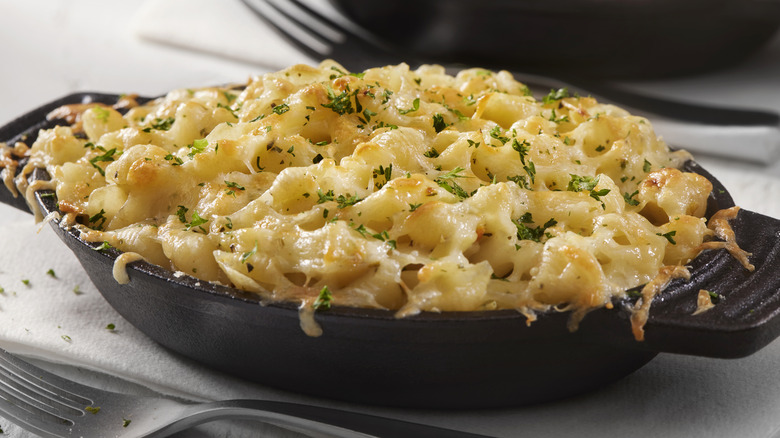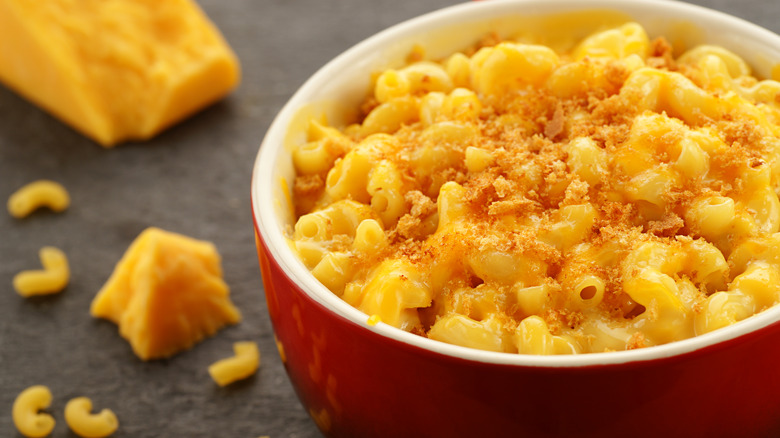Thomas Jefferson Shouldn't Get Credit For Bringing Mac And Cheese To The US
In the United States, any potluck, barbecue, or holiday party is bound to have a tray or two of macaroni and cheese. While the popular dish may seem distinctly American, (Americans certainly love cheese. Just look at the government's secret cheese cave!) it actually has origins that date all the way back to ancient Rome when folks first discovered the life-changing combination of cheese and pasta. Over the centuries, different cultures played with mac and cheese's textures and flavors until 18th-century French chefs transformed it into the creamy meal we know and love today. As for how it made its way over to the States, one common story is that Thomas Jefferson introduced the dish after he brought a macaroni machine over from France. This is not the full truth. While Jefferson did supply the macaroni machine, the person who actually did all the cooking and who deserves the credit for popularizing mac and cheese in America is the third president's enslaved chef — a man named James Hemings.
James Hemings was born into slavery in 1765. He and many of his family members worked at Monticello, Thomas Jefferson's family estate in Virginia. Accounts say that Jefferson had a trusting relationship with Hemings. That trust doesn't make up for the injustices Hemings suffered as an enslaved person, but it may be what inspired Jefferson to bring Hemings with him on an emissary trip to France in 1784. There, Hemings would learn the secret of mac and cheese.
Mac and cheese was brought to America by James Hemings
While Thomas Jefferson spent the trip to Paris meeting with French delegates, James Hemings used the time to learn the art of French cuisine. Throughout his training he worked with prestigious chefs, learned pastry techniques, and even cooked for one of the French princes. Three years later in 1787, when Hemings was only 22 years old, he was working as the head chef at Paris' American embassy. To gain an even deeper understanding of French cooking, Hemings even used his own money to learn the language. It's theorized that learning French also allowed Hemings the opportunity to learn more about the various discussions on freedom and liberty that were happening in the country and how that related to him as an enslaved person.
It's likely that Hemings learned the recipe for mac and cheese while working in French kitchens, and then put his own twist on it, as evidenced by his 1787 recipe for "macaroni pie." He also probably served the dish at Hôtel de Langeac, the American embassy. Presumably, Hemings' dish was delicious enough to inspire Jefferson to bring a macaroni machine back home in 1789. The next year both Jefferson and Hemings would work in Philadelphia (though Hemings was still enslaved). In the then-capital, Jefferson served as Secretary of State while Hemings prepared meals for the biggest names in politics at the time. And as you may know, political dinners can get historically wild.
James Hemings' legacy
After James Hemings petitioned Thomas Jefferson for his freedom, Jefferson said he would grant it under the stipulation that Hemings could train another chef to cook just as well as he could. A tall order, but Hemings successfully trained his younger brother Peter, and became a free man in 1796. Over the next few years, Hemings would travel and cook around the burgeoning new country, and even returned to Monticello for a stint of paid work. Tragically, James Hemings passed away in 1801 when he was only 36 years old.
American foodies actually have a lot to thank Hemings for popularizing, including french fries and ice cream. It's vitally important that we don't omit Hemings' name from the story of American cuisine. Doing so erases the history of enslaved people in the United States and the endless ways that they influenced the country's culture. It also disregards Hemings' extreme talent as a chef. If we were able to taste his food today, we'd no doubt notice the blend of French and American flavors, as well as the culinary stylings that were unique to his community and that would go on to inspire modern Black American food. The next time you sit down for a hearty meal, don't forget Hemings' story, and make sure to make your mac and cheese as creamy as possible.


